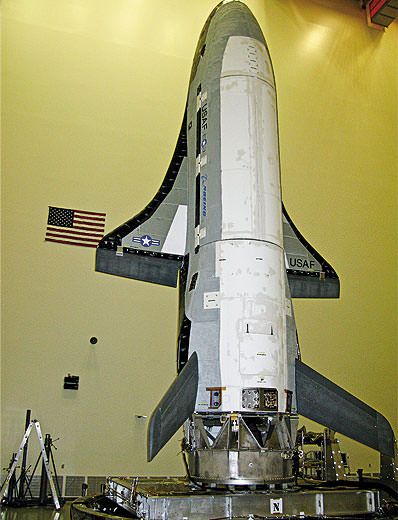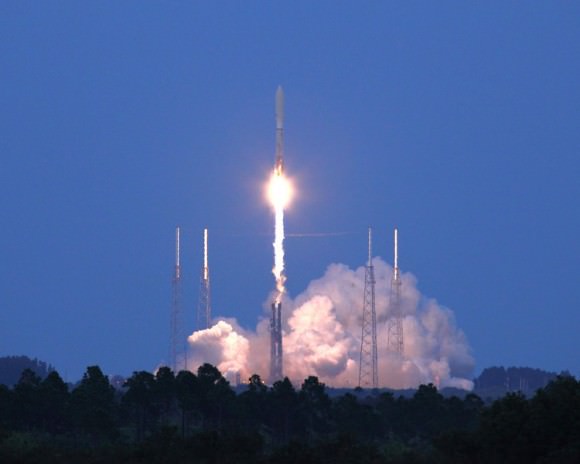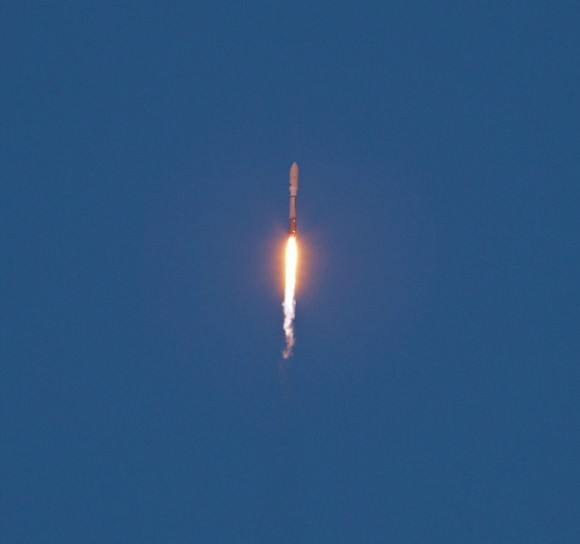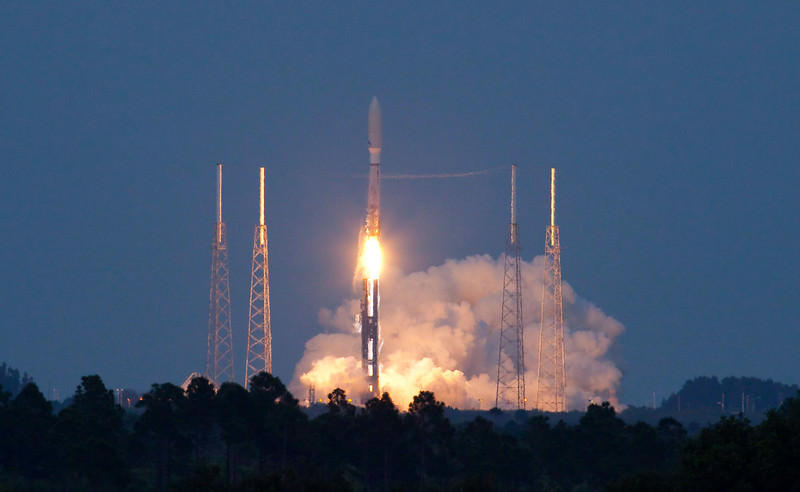A secret Air Force space plane launched on an Atlas V Thursday night at 7:52 p.m. EDT (2352 GMT) on a classified mission. The vehicle, the umanned X-37B Orbital Test Vehicle, looks like a mini space shuttle and has the capability to remain in orbit for 270 days. The purpose of this vehicle – for this mission and for the future – is unknown, but the Air Force says this newest and most advanced re-entry spacecraft will demonstrate autonomous orbital flight, reentry and landing.
Although the mission is secret, the launch was open to the media and was webcast live by the United Launch Alliance, and included live Twitter updates from the Air Force Space Command. Shortly after main engine cutoff, however, the webcast ended and no more updates were provided about the rocket and the vehicle’s activities.
[/caption]
The mission duration has not been disclosed, but the Air Force said technologies to be tested during the flight include advanced guidance, navigation and control, thermal protection systems, avionics, high temperature structures and seals, reusable insulation and lightweight electromechanical flight systems.
Liftoff occurred on time; and the stages separated 4 minutes and 31 seconds into the flight, and engine cutoff came at about 17 minutes after launch.

The X-37B is 9 meters long and 4.5 meter wide (29 X 15 ft) and its payload bay is 2.1 by 1.2 meters (7 by 4 feet). The vehicle was built at Boeing Phantom Works, based on an orbital and re-entry demonstrator design initially developed by NASA, then handed over to the Pentagon.
Rumors of an X-37B launch have been circulating since 2008.
Originally the vehicle was scheduled for launch in from the payload bay of the Space Shuttle , but that plan was axed following the Columbia accident.
Comparing the X-37B to the space shuttle, the orbiters 56 meters (184 feet) long, has a wingspan of 23 meters (78 feet), and weighs 2 million kg (4.5 million pounds.)
The space shuttle can haul payloads up to 29,500 pounds, while the OTV can only handle up to 226 kg (500 pounds.)
The X37-B will land on a runway in California and will be controlled remotely from the ground. In the future, the Air Force said they hope to conduct experiments and rendezvous with other spacecraft.
See our preview article about the X37-B.
Enjoy more launch images from Alan Walters:




Ah, the latest weapon in USAF’s war against their traditional enemy, NASA.
ah so this thing was supposed to fit in the shuttle’s cargo bay. That would have been interesting to see, except for the top secret part.
Do the words “Farscape 1” pop up in anyone else’s mind when they read this article? 🙂
The development of this thing is moving at relatively lighting pace compared to NASA these days. There is already talk of a second one to be made ready for next years launch.
I wonder how long it would take Boeing to make a manned version of this thing if we turned them loose with a blank check.
It seems like just the kind of mail carrier the ISS has been lacking.
Maxwell,
Or a manned version that carries 5 people and no cargo that sits on top of the rocket instead of on the side. It would be smaller than the shuttle obviously.
Maybe all spacecraft evolve until they have wings and land on an airstrip.
But an Apollo/Soyuz style capsule is probably most economical and secure way to bring people down from orbit.
Capsules are more efficient for high speed lunar returns, but we aren’t doing that. They cost less for a dozen flights than developing a reusable, but will that savings add up over hundreds of missions?
The RLV is where the future leads if space is ever going to be an affordable (at far less than $10k a pound) destination. Give it three seats and cargo, you’ve at least got the Soyuz program beat for a reasonable price in a short time span.
I think the only thing that would have made this more like the ship we want is to have a recyclable first stage or air launch system to put a dent in operational costs.
At that point it wouldn’t matter what it cost to develop, we’d make it back eventually.
Hopefully this thing has some awesome secret payload capability, like lasers that can melt people from space.
Whatever it is, I can’t see the US military having sunk multiple hundreds of millions into this project just so that it can pussy foot around up there and dock with other spacecraft.
Mind you, I guess it could be an unmanned spy satellite re-fueller or something, but you’d think it’d be more stealth if that was the case. They certainly wouldn’t be painting the damn thing white!
(shhhhhhhhhhhh..!!!)…8^)
Want to see the seperations not in Cartoon?
http://www.youtube.com/watch?v=NqqH5IwWeo4
I caught it From over 60 miles away…8^)
PS, if your not into heavy metal music, mute the video
Yes, that’s right vagueofgodalming
And for the human space flight fans within NASA, a fully automated Shuttle-like spacecraft is another fine demonstration of how much can be done when you leave the rocket jockeys (aka Astronaut Corps) on the ground.
Yay Phantom Works
Orbital maneuvering has always been a goal in spacecraft development. and although the X-37B does not seem to have the fuel capacity for much of that(?) it seems reasonable that there would be an effort to find alternatives. Plasma jet propulsion anyone?
The ability to rendezvous with multiple targets, while not being seen by radar (Stealth modes) would have a distinct advantage. I wonder what the Chinese have up there?
EMP generators have come a long way in recent years. The ability to knock out a foes orbital resources without being detected from the ground and not creating hundreds or thousands of pieces of debris might be prudent?
Just guessing….
We have proved that Man can live on a pile of metal, jury rigged together and floating in zero gravity, and zero atmosphere. It’s a much easer task putting together a much more usable and lasting space station on a solid surface … the Moon instead of the Earth. Using our space/way station for interplanetary, back and forth trips, to our sister world the Moon and using relatively cheap throw away, return vehicles for the hop, step, and jump back to Earth short term and this reusable space plane in the long run makes a lot of sense.
Maybe its just me, but isn’t it just a tad ironic that this top secret U.S. mission was launched using Russian rocket engines in the booster?
Hmmm. I wish there was some more information about this…. Stupid USAF keeping everything secret.
Anyway, I hope that they share this technology. It is just what NASA needs right now. And maybe it could be licensed to Boeing to be mass produced. That could probably bring costs down quite a bit. And does anyone know if maybe one of the SpaceX rockets could carry it. They’re supposed to be cheaper. Yet another promising technology…
It’s fascinating to speculate about the future of the X-37B beyond it’s obvious use as a technology demonstrator.
With a mission duration of up to nine months and sufficient fuel, the X-37B could easily venture beyond the LEO limit of the Space Shuttle and conceivably fly to GSO, to hang out with expensive and vital military assets like MILSTAR, FLTSATCOM and the UFO System.
The X-37B payload bay is to small to capture, stow and return with these assets, but it could possibly carry robotics for an on-orbit service, repair, or refuel mission. It could also capture space junk that might threaten these assets.
Something like the 200 kW VASIMR engine (to be flown to the ISS in 2011-2012), would give the X-37B highly agile manoeuvrability and range if the power requirements can be satisfied.
Maybe the X-37B’s future will include working with micro satellites.
Most likely Aqua is on the right path and it’s main uses include being a stealthy platform for satellite killing/snooping weapons.
@whatsup
Putting a space station on the moon would be extraordinarily expensive. Not to mention (for many reasons) technically challenging. If you don’t understand why this is, I suggest you do some research on this. If you like, there are articles on this very problem written here on UT. I suggest you read them before making naive statements.
Also, the moon IS NOT A PLANET. I have sent you a link before on this. What part of the definition of a planet do you not understand?
I did a little poking around to find out more about the RD-180 rocket engines the Atlas V uses. It was originally developed for the Buran Russian shuttle as the RD-170. That engine was a cluster of 4 nozzles rather than the 2 on the Atlas V. The RD-170 was later modified and adapted for the Ankara rocket program. THAT rocket looks very interesting! Idea being, the booster section has a folded wing and 3 fins on the tail section. After boost phase the wing rotates 90 degrees and a jet engine in the ‘nose’ then fires up and the whole booster would be able to fly back to where it was launched! Very innovative! Those clever Ruskies!
The Ankara looks a bit like the Pegasus rocket in profile. But the similarity ends there… its much more powerful engines means that it will be able to launch much heavier payloads to LEO and beyond.
Aqua,
Well it definitely shows Russians are embracing capitalism by selling hardware to other countries like the US.
Hello Aqua,
Is it possible that you refer to the Angara rocket family (ie http://en.wikipedia.org/wiki/Angara_rocket)?
A search for “Ankara rocket” revealed only that Iran have a rocket which can reach as far as the (beautiful) Turkish city of Ankara.
Aside: A recent Iranian space rocket had a turtle and some earthworms for a payload, so if this is the Ankara rocket, it remains unclear who would be most surprised on it’s reaching it’s destination. The Turks or the Turtle.
😉